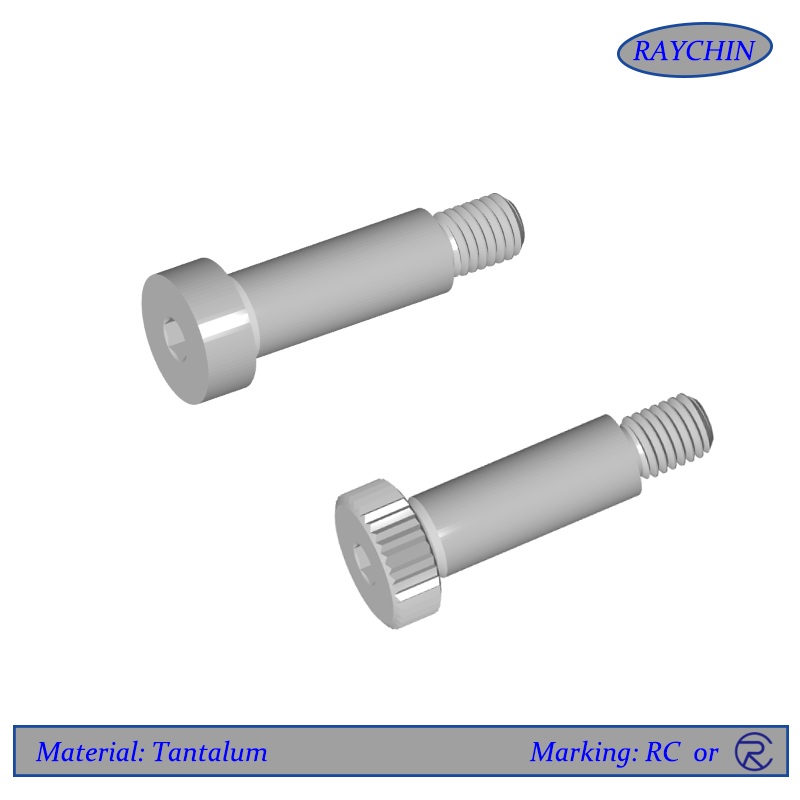
Tantalum Shoulder Bolts
Brand RAYCHIN
Product origin CHINA
Delivery time 5-35 DAYS
Tantalum shoulder bolts are best known for its unmatched corrosion resistance and chemical inertness. Tantalum bolts have a similar corrosion resistance to that of glass, but all of the typical mechanical and electrical properties of a metal.
Tantalum shoulder bolts are also extremely stable at high temperatures, since tantalum has a melting point around 3000°C. High temperature applications require vaccum or inert gas since tantalum may embrittle when used in oxygen rich environments above 250°C. Tantalum bolts are also one of the most bio-compatible metals available and is also radio-opaque due to its high density (16.68 g/cm3).
All tantalum shoulder bolts are available in commercially pure tantalum and tantalum 2.5% tungsten (Ta-2.5%W).
Tantalum Shoulder Bolts
Tantalum shoulder bolts are best known for its unmatched corrosion resistance and chemical inertness. Tantalum bolts have a similar corrosion resistance to that of glass, but all of the typical mechanical and electrical properties of a metal.
Tantalum shoulder bolts are also extremely stable at high temperatures, since tantalum has a melting point around 3000°C. High temperature applications require vaccum or inert gas since tantalum may embrittle when used in oxygen rich environments above 250°C. Tantalum bolts are also one of the most bio-compatible metals available and is also radio-opaque due to its high density (16.68 g/cm3).
All tantalum shoulder bolts are available in commercially pure tantalum and tantalum 2.5% tungsten (Ta-2.5%W).
When nickel, titanium or zirconium alloys are not enough...

· Immune to numerous acids and chemicals (corrosion tables)
· Better corrosion resistance than nickel alloys, titanium or zirconium
· High strength and stiffness in vacuum and inert gas up to 2000°C (3600°F)
· Can become brittle when used in oxygen above 300°C
· High purity and biocompatibilty
· Physical Properties
· Tantalum grades, specifications and chemistry
· Datasheet for tantalum
· Tantalum shoulder bolt features and benefits
Resources: Tantalum Torque Spec
Bolt Types Available: Hex Bolts, Shoulder Bolts
Tantalum Shoulder Bolt Features and Benefits
Tantalum shoulder bolts, also called stripper bolts are a unique fastener with three main parts: head, shoulder, and thread. The head has the largest diameter and is where the torque is applied, typically with a socket driver. The shoulder is smooth and unthreaded, and has a set diameter and length. The shoulder’s role is to act as a shaft or dowel for rotating parts, axles for rolling parts, guides for sliding elements, and pivot points. The final part of a tantalum shoulder bolt is the threaded shaft. The threaded portion of a shoulder bolt has a major diameter slightly smaller than the shoulder diameter.
Tantalum Grades, Specifications and Chemistry
Tantalum (Commercially Pure)
Commercially pure tantalum metal is 99.95% pure tantalum has some o the best corrosion resistant properties of any metal. While its corrosion resistance is exceptional, it is relatively soft and mechanically similar in strength to copper.
Tantalum Specifications: UNS R05200, ASTM B521, B708
Tantalum (CP) | Ta | Nb | W | Mo | O | Ti | Ni | Fe | N | C | Si | H |
Max% | >99.95 | 0.100 | 0.050 | 0.020 | 0.015 | 0.010 | 0.010 | 0.010 | 0.010 | 0.010 | 0.010 | 0.010 |
Tantalum 2.5% Tungsten (Ta-2.5W)
This grade of tantalum alloyed with 2.5% tungsten provided better overall strength while maintaining its exception corrosion resistant properties. For tantalum fastener applications this is usually preferred.
Specifications: UNS R05252
Tantalum 2.5%W | Ta | W | Nb | Mo | O | Ti | Ni | Fe | N | C | Si | H |
Typical% | Bal | 2.5 | 0.50 | 0.020 | 0.015 | 0.010 | 0.010 | 0.010 | 0.010 | 0.010 | 0.005 | 0.002 |
Physical Properties
Density 16.6 g/cc
Melting Point 3290 K, 2996°C, 5462°F
Boiling Point 5731 K, 6100°C, 9856°F
Coefficient of Thermal Expansion (20°C) 6.5 x 10(-6) / °C
Electrical Resistivity (20°C) 13.5 microhms-cm
Electrical Conductivity 13% IACS
Specific Heat .036 cal/g/°C
Thermal Conductivity .13 cal/cm(2)/cm°C/sec
Tantalum Tensile Data
TANTALUM - Tensile Data
Temperature (°F) | Ultimate Tensile (ksi) | Yield Strength at 0.2% Offset (ksi) | Elongation % |
Room Temp. | 40.0 | 25.0 | 50.0 |
200 | 29.0 | 22.0 | |
400 | 28.0 | 12.0 | |
600 | 28.0 | 8.0 | |
800 | 27.0 | 2.5 |
TANTALUM 2.5% W - Tensile Data
Temperature (°F) | Ultimate Tensile (ksi) | Yield Strength at 0.2% Offset (ksi) | Elongation % |
Room Temp. | 50.0 | 35.0 | 25.0 |
200 | 48.0 | 30.0 | 15.0 |
400 | 42.0 | 27.4 | 10.0 |
485 | 40.0 | 25.5 | 10.0 |
Tantalum Iso-Corrosion Curves


Tantalum Corrosion Resistance Table
TTantalum Corrosion Resistance Table
TANTALUM SHOWS A NIL CORROSION RATE TO THE FOLLOWING MEDIA For all temperatures up to at least 302F (150C) unless otherwise indicated | |||
Acetic acid | Chlorine, dry, <250°C (480°F) | Maleic acid | Potassium sulfate |
TANTALUM SHOWS LIMITED CORROSION RESISTANCE TO THE FOLLOWING MEDIA | |||
Air,>300°C (570°F) | Hydrogen, >300°C (570°F)Hydrogen fluoride | Potassium hydroxide, conc. | Sodium hydroxide, conc. |












